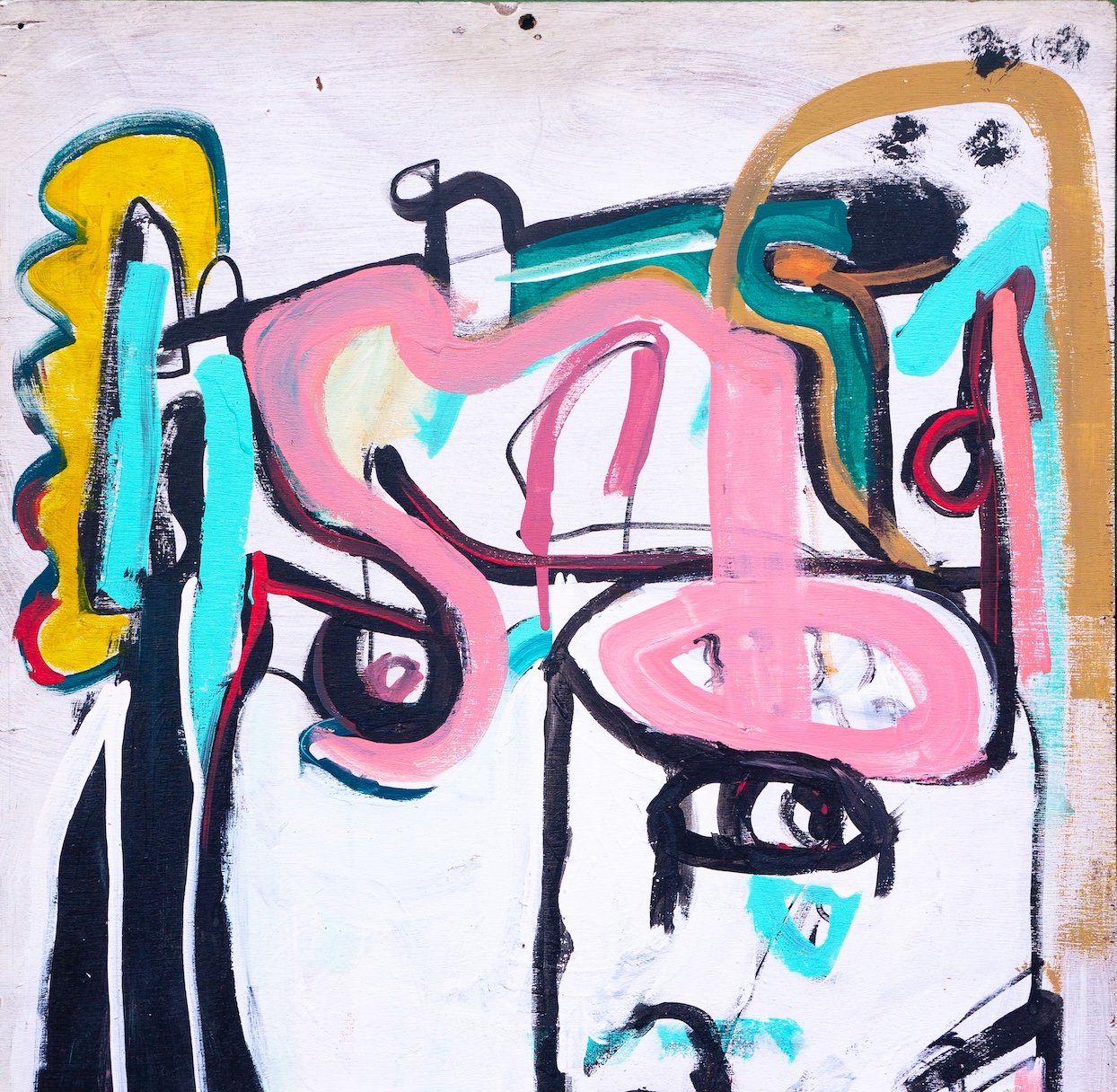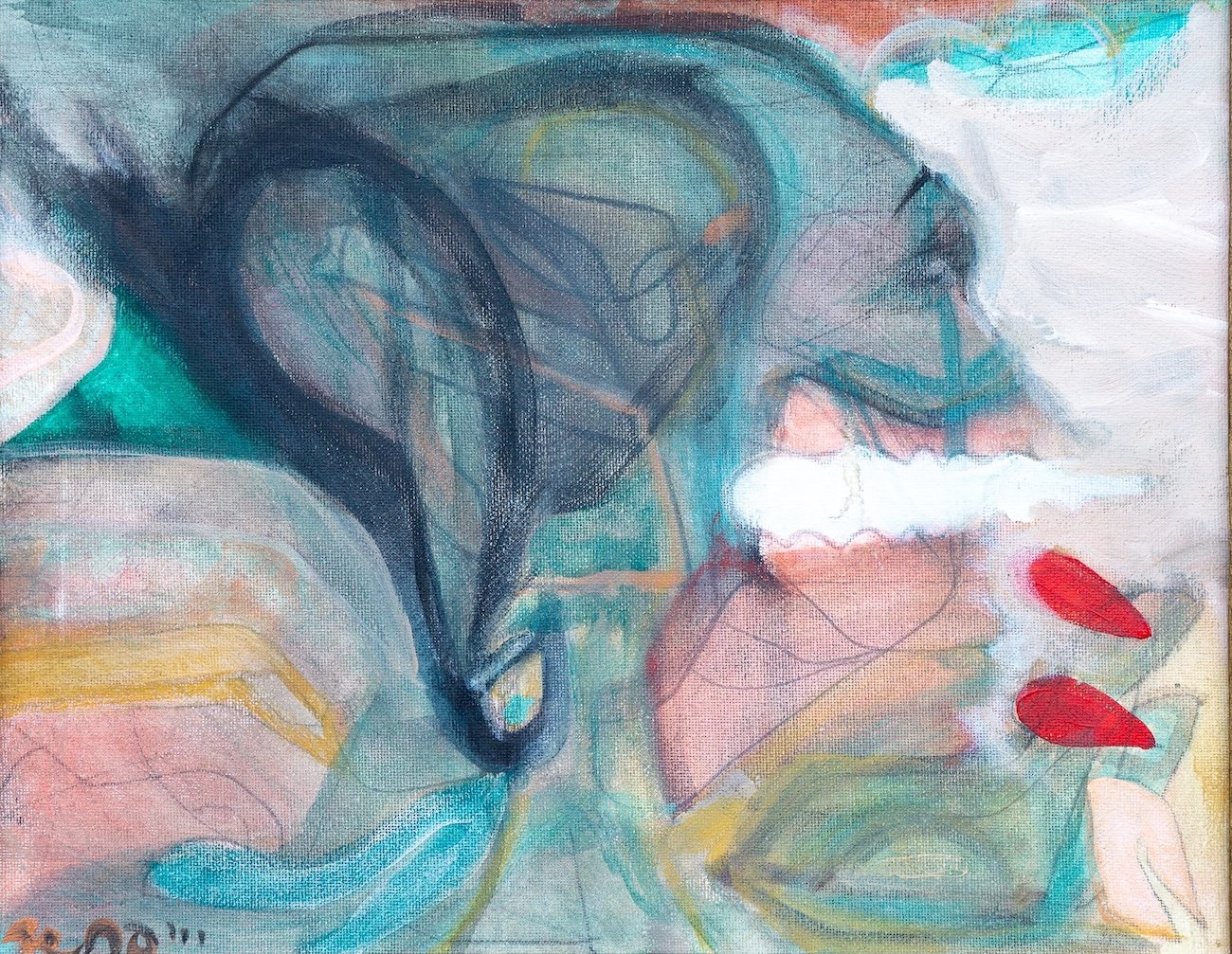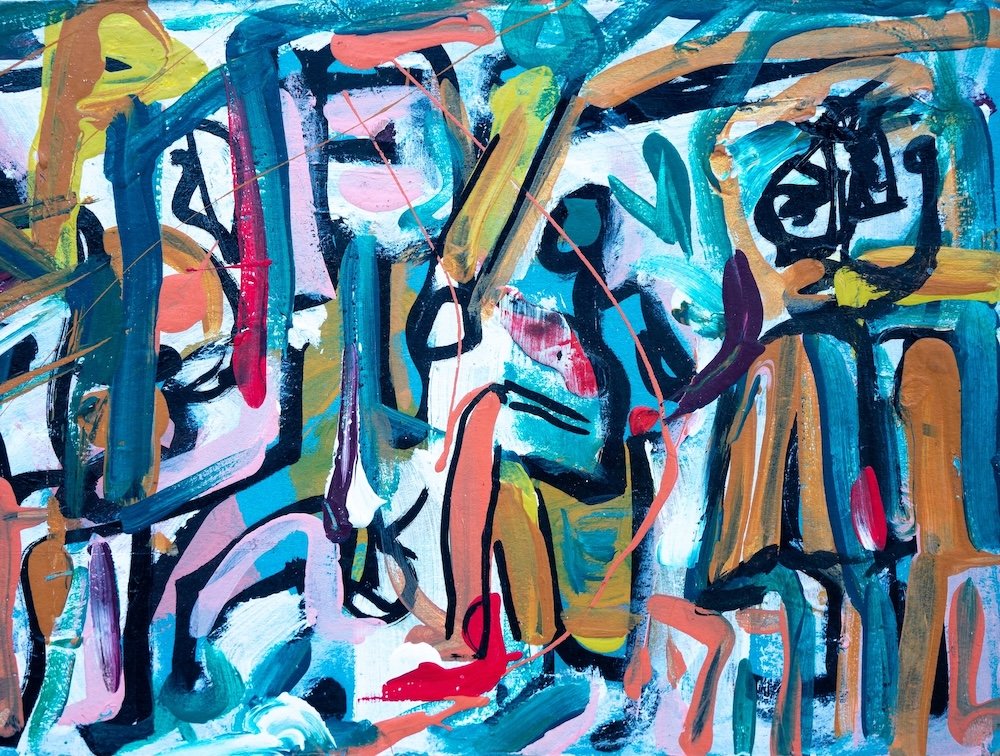Interview with artist Zeno Schaefer
Zeno Schaefer is a full-time artist living in Russellville, Arkansas. He continues to experiment with his art as his style evolves. The result is a body of amazing work that forces the viewer to dive in – without floaties. More of Zeno’s work can be found at Gallery 26 in Little Rock and at his Instagram. (Profile photo by T.B. Merritt)




AAS: Zeno are you originally from Arkansas?
ZS: Well, sort of. My mother is from Arkansas, but she met my father in Los Angeles and I was born in San Diego. I lived there until I was dropped off at my grandparent’s house in Dover, Arkansas when I was five while my father finished up and retired from the Navy and my sisters could finish out the school year. We eventually moved to Russellville, where I went to school until I joined the Navy and moved back out to San Diego. After I got out in 1995, I studied Art at Arkansas Tech University for a couple of semesters. I spent my 20’s and 30’s going back and forth roaming around, mostly out west, living in Flagstaff, Portland, Oregon, and Chicago before ending up in Oklahoma City the last 10 years before moving back home in 2013. I feel like a native, but I can’t wear the t-shirt.
AAS: Were you always the creative type? When did you first start painting?
ZS: Yes, as long as I can remember, either consciously, or subconsciously. I loved pens. I still do. I remember when I was around eleven or twelve I started making pictures for myself, not for a teacher or for my mother to hang on the fridge. I used pens, and hi-lighters on graph paper and I still have my first graph paper sketch book. I didn’t start painting until recently. I didn’t have any “artist” role models growing up, except for my father who was an artist but he either didn’t know it or would have never accepted it. I drew then like I do now by finding what’s inside myself.
AAS: Your work makes me think of the Spanish painters Picasso, Miro and Gris. Who are some of the artists who give you inspiration
ZS: Early on, I didn’t know much about other painters or even art in general. I wish I had taken an art history course in the short time I was at ATU. Though now I am very interested in art history. I do get the Picasso comparison a lot, but I think you could almost compare every contemporary artist to him in some way. He was like The Beatles of painters. He did everything well. But like The Beatles, who I love, I don’t listen to them very often anymore because they got me to bands like the Pixies and then to Built to Spill and Pavement, to Dr. Dog and Destroyer. I have heard it said that there’s nothing new and everything’s been done. And yes, because of artists like Picasso, Klee, De Kooning, and Diebenkorn and many others, everything has been done. But I think it is our job as artists, like it was their job, to make sure art keeps evolving. I think all artists at heart are evolutionists, breeding new ways to say the same things. I will always listen to The Beatles, and I will always love Klee, but who I’m watching and who are inspiring me at the moment are my comrades and contemporaries like Lulu Bennett, Misha Bart, Millo, and Joram Roukes.
AAS: I want to ask you first about fATLAS. It is a marvelous composition of abstraction, representation, and surrealism. I love it! Tell me about it.
ZS: Thank you, I am very proud of this piece. I feel like as artists we try to make work that legitimizes being referred to as such, or more so being able to call yourself an artist. fATLAS started out being one of three panels, that as an exercise, I crudely drew out three different design ideas in Sharpie. This one is the first I started working on. It was many different paintings until fATLAS was revealed to me, and at one time it was a woman. I remember working on that painting all night in my studio while the sun was coming up. Being a novice with the human form and face, I typically make pretty wide strokes leaving an impression of a cheek bone, or an upper lip, etc., but I remember having so much fun moving him to a her and back again thinking about what it is that makes a nose feminine, or masculine. An eye is an eye, an ear is an ear, but what is it that makes one a man’s and one a woman’s? I found it completely fascinating, and fell in love with painting that picture, and so I worked really hard on him because I felt that that piece deserved to be good, technically.
fATLAS, 24" x 54", oil, acrylic, charcoal, ink on birch
AAS: Something quite different is Psychopomp. Tell me about it.
Psychopomp, 48" x 36", acrylic on birch
ZS: Psychopomp was painted around the time that I began blending my two styles in a way that’s different than my murals. You start to see the familiar shapes that I use, but I am trying to be less precise with my application. I did this and won my first juried show (Art & Flowers) in which it was presented with a bouquet, and so I thought this style was something I should continue with. I like getting “outside the lines”. I like making art with less thought and more feel expressed in my stuff.
AAS: You’ve said that you like the idea that the person who is looking at one of your paintings is also creating it at the same time. What do you mean by that?
ZS: I began using paint in 2021. It was a dark time for me, Covid sort of wiped me out. I had been shut in for about two or three months when I saw a structure that had been in place for a while, newly painted white. I mentioned to friend of mine that someone should paint a mural on it, then I had the thought that I should paint it. So, I spoke with a man named Steve Bennett, and said that if he would supply the paint, I would paint it. He asked me how long it would take and I said two weeks – it’s been three years, but I’m almost done. Anyway, that’s when all the very small pen and ink 003 micron line work stuff that I did very small, started becoming very, very big, with color. I could not believe how forgiving paint was, and how you can carve out what you like and start over where you don’t. So, as I began to make progress and people would pass by, I would start getting all these different interpretations of what they were seeing, and none of them saw what I thought I was painting. I was also working on a big 4’x8’ commission at the end of that year, and as my kids would be traveling in and out of the kitchen, they would shout out whatever animal they saw. I try to have a “connect the dots” feel to my work, but I soon realized that people connect them in very different ways. This makes my work unique to whoever is viewing it – they are creating a piece individually for them.
5&6, 4’x 8’, ink and stain on birch
AAS: I guess for me, Whole Point of Everything is a good example of one of your paintings asking me to blink three or four times to grasp it – and to tilt my head. It almost becomes interactive!
Whole Point of Everything, 54" x 24", oil, acrylic, chalk on birch
ZS: Whole Point of Everything is a very large piece. It is also a continuation of blending my two different styles together as a concept, or rather bring two different concepts together. I feel like if I were tasked to title my style of art I would call it Moot Art and so as a “Mootist” painter I want my work to be open for discussion, and for it to be questioned, up for debate and for a consumer to be uncertain about what they are seeing until they are. Whatever meaning that piece has for me, it is in no way what I’m trying to project on the canvas. I just want people to be moved enough to think about it, and perhaps instead of asking me what I felt when I was painting it, I want them to ask themselves how they feel when they look at it. Almost as one would when looking at a Rorschach test. Sometimes when I hear what people are seeing, I say that’s not me man, that’s you! And that’s it – that is the whole point. Who were you before you heard a band or saw a piece of art that changed your life? Who are you, or what are you going through that made you interpret the art the way you did? And, who did you become after? How has it changed your life?
AAS: Dream Beaux is a wonderful painting but suggests maybe an internal conflict – I guess from the eyes. Is painting a way for you to work through your emotions? Or is painting always fun for you?
Dream Beaux, 20" x 16", oil pastel on canvas
ZS: Thank you. I would have to say almost everyone, me included, battle with a range of large scale to small internal conflicts most days their entire lives. Occasionally, my internal conflict is with the art itself. It took me a long time to understand that my paintings, at least the good ones, rarely fall out onto the canvas. You have to be dogged. A painting is a bad painting until it’s finished. I think it’s typical that most portraits are painted with some melancholy, nobody wants to see happy. Who the hell is happy? So, I would have to say that I usually do not use my art to work through my emotions, I generally stick to brooding, and pouting…..
Yes, painting is always fun for me. If it’s not, I stop. Until recently, my art has solely been for me, I would lie awake at night and pet my art like Gollum and his Ring. I really don’t think that I would be doing it on the scale that I am if not for losing everything.
An artist needs, time, space and money. When my wife left and I lost my job, I was left with time and space. The money wasn't there, but I lived with a simple philosophy of time versus happiness. The less that it takes for you to be happy, the more time you can devote to what does. I did still have bills, and a mortgage, and birthday presents, Christmas, and food and cigarettes. When you are poor, you need a hustle, so making art became that hustle. I became an artist trying to keep the lights on and trying to keep what I had left. I got a small gig that I grossly underbid while I was working on a billboard, and then I started drawing on light switch plates, taking them around to little shops selling them for 10-20 bucks a piece. I then rented a booth in a local flea market and started selling my art out of there until I started getting more commissions and pretty much painting full time. I had always wanted to be an artist, but I couldn’t trade working for painting. But because I wasn’t working, I could paint, and did paint, a lot. But making the art is one thing, showing it, and selling it is another. This is what is not fun. Making social media work for you is a full-time job. Then, I would set up for art walks and forget to bring change. I didn’t put any thought into how much I would sell a piece because for one I didn’t think anyone would want it. It still sort of shocks me today, but I’m getting better at it.
AAS: So how do you begin a piece? Do you just start drawing and then let the drawing tell you what colors to use?
ZS: My process is an organic one. I begin with line, line begins to create form, and color starts to create subject and space. And I use everything. My preliminary sketches and early color pallet will end up as my underpainting usually. For the last year or so, I have been focusing on subject matter, and I can tell this year I started to switch my attention to my color pallet. I have always been afraid of color, and I don’t think that I’m very good with it. I’ve always drawn in the abstract, but I have played around with realistic sketches, human form, portraits and so forth, but color is something relatively new to me.
When I began to draw bigger at the beginning of 2021, I mainly used birch as my canvas and I started using stains, so I was limited to blondes, and browns and ambers mainly, until I discovered I could thin down latex to get different hues of greens and blues and more vibrant oranges and reds and still see the grain, but it also muted the colors in a safe way for me to dip my toes in the world of color.
AAS: Your Untitled in ink and stain on birch is one of my favorites. It is an extraordinary piece. It suggests to me that you really like the drawing aspect of your art. Is that true? Tell me about it.
Untitled, 36" x 24", ink and stain on birch
ZS: Thank you. One of the biggest compliments I’ve ever received was by someone who recognized one of my pieces to be one my pieces only by the art itself. I think I would much rather be original than good.
It takes a lot of thought and precision when you are working with ink. With ink you can only add more ink. It is not as malleable as paint, so you have to know when to stop, and when to be brave. Drawing needs to be more contained than painting. I find the process very comforting. I refer to it as my collaborative work where the viewer becomes the artist, transforming what they are seeing into something individual for themself. In this style is where I am most organic. The piece is an abstraction beyond comprehension, but I feel this is where I need to allow my audience to be able to engage with my work. It is something I’ve always done and it’s because it’s fun as hell. I love waking up in the morning after drawing late and sort of forgetting where I was with a piece – it’s like Christmas.
AAS: Tell me more about your mural work and your efforts to inspire the next generation of artists.
Mural for the Joseph House foster care facility on the Arkansas Tech University campus.
ZS: It really began few years ago when I was invited to teach mural painting in an afterschool art program with my girlfriend and I feel it was something that I took to. It definitely was something that I enjoyed and started thinking a lot about. I feel like this art style is important, especially to young children. I feel this is something they should be shown at a very young age. It wasn’t until recently that I was visiting with my mother, and I was going through a photo album and came across a picture of my father holding me when I was around one or two in our backyard in San Diego. I had seen the photo a couple times growing up but for some reason that night I looked past me and my dad and noticed that on our wooden privacy fence he had nailed up these crazy shapes of scrap pieces of plywood that were left over from a job or a project that he had done and were all painted different colors. And when I looked even closer, I noticed they were the shapes that I use in my art all the time, definitely in the style of what I do now. I think being exposed to art in this fashion at a young age turns something on in your brain. In my case something stuck.
As far as my classes, in most cases these children did not have a choice whether to attend this program or not. It was made by a parent, and you could soon figure out who was going to be interested in art as an artist and who was not. So, I soon realized it was important that I didn’t approach this as making artists out of these children but to hopefully teach them an appreciation for art, not necessarily to grow up to be artists but to grow up to be advocates.
I love making art. I will always do it because I have to. In hindsight I always have, even when I thought that I wasn’t. When I wasn’t drawing, I took photographs with my AE1 that I took everywhere. Art is in the way that I speak, the way that I dress, how I decorated my apartments, how I raise my children – it is in everything that I do. Being an artist is the only thing I ever wanted to be, even before I knew that it was something you could be. The thought of it would be like getting paid to eat breakfast. I just knew I never wanted to be anything else.





